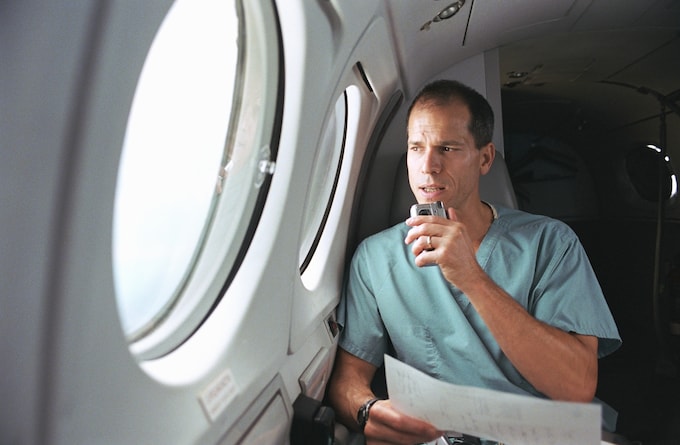Imagine that you’ve suffered a heart attack while traveling onboard a commercial airliner.
Now imagine that a trained physician is a phone call away, ready to advise the aircraft’s crew what actions they should take to save your life, whether it’s using the onboard defibrillator to restart your heart or diverting the plane to the nearest airport with a medical facility able to deal with the emergency.
That’s the service offered by MedAire, which allows client airlines immediate access to emergency care doctors whenever the need arises to supplement crew members’ medical training.
Joan Sullivan Garrett, a critical care, registered flight nurse, founded MedAire in 1985. Her experience in helping patients in desert areas of the Southwest convinced her of the need for providing emergency medical care to people in remote locations. She continues to serve as the organization’s chairperson.
Initially, she trained business aviation pilots and flight attendants in handling in-flight illness and injury. In 1987, she created the service whereby flight crews can call during an in-flight medical situation and be immediately connected with an emergency room doctor for advice.
MedAire subsequently was acquired by International SOS, a privately owned company headquartered in Singapore that provides medical assistance, security, evacuation, travel and consulting services worldwide.
In addition to providing in-flight medical assistance and passenger evaluations, MedAire also provides first-aid training for airline crews and advanced medical kits and equipment for airlines. In addition to serving business and general aviation clients, the company also provides medical assistance services for yachts.
MedAire, which is headquartered in Phoenix, also helps airline crews in need of medical attention receive care while away from their home base.

A trained physician is ready to advise the aircraft’s crew what actions they should take (Credit: MedAire)
According to Dr. Paulo Alves, MedAire’s global medical director of aviation health, the organization has a doctor, based at University Medical Center in Phoenix, on duty to handle an average of 300 medical calls a day.
Despite that fact that nearly 800,000 people are flying at any one time, Alves said true in-flight medical emergencies are relatively rare.
MedAire reports that the vast majority of calls it received qualify as medical events. They include gastrointestinal complaints (32 percent), such as food poisoning or neurological (24 percent), or respiratory (7 percent).
According to statistics maintained by MedAire, 6 percent of its calls involve cardiovascular illness, which Alves described as the true medical emergencies. This could include a passenger suffering a heart attack or a stroke.
Alves described the procedure for obtaining medical assistance from MedAire: The crew aboard the airliner with a passenger who has suffered a medical event contacts a MedAire communications specialist who determines the aircraft’s location, destination, and nature of the medical situation. These specialists are familiar with the particular jargon used by in-flight personnel and facilitate communication between the aircraft and the physician.
Alves notes that a MedAire doctor deals with each call received and can make as many at three recommendations for how the crew should best handle the medical event.
If the medical emergency is so serious that it’s recommended that the flight is diverted to a nearby airfield, numerous operational considerations come into play, including the security situation on the ground, the level of medical assistance available and whether the airport has the physical capability to handle the aircraft.
In each instance, the ultimate decision on how to proceed rests with the aircraft’s pilot.
Sometimes, the advice offered by a trained emergency room physician is the exact opposite of the actions a flight crew or volunteers might take.
In the case of fainting, for example, fellow passengers or crewmembers seeking to help the victim often do exactly the wrong thing. Alves said. Instead of keeping the passenger seated upright, a MedAire physician would recommend laying the patient flat in the aisle to allow blood to more effective circulate to the brain and speed recovery.
Of course, both MedAire and the airlines that subscribe to its services would prefer to eliminate in-flight medical events from occurring in the first place. That’s why, Alves said, educating the public on the hazards of traveling with certain medical conditions is one of its key objectives.
He added, however, that it’s difficult to prevent a “determined passenger” from boarding a plane, regardless of their condition.
“We’ve seen people arriving at the gate with their hospital bag after just undergoing surgery,” Alves said. “They just want to go home – it’s a natural thing.”
Expectant mothers sometimes mislead airline staff concerning their due date so they can fly home to give birth. An airliner, however, is hardly a sterile environment and presents a tremendous risk for both mother and child.
Alves advises pregnant women, “If you’ve had a complicated pregnancy, if you’ve had any sort of difficulty prior to the flight, please don’t fly.”
Airlines are also seeing a new category of passenger: medical tourists.
These are people flying from their home countries to places like India or China to received complicated medical procedures, such as heart surgery or the installation of pacemakers, at greatly reduced prices.
Jordan, for example, has become the destination of choice for those seeking gastric weight-loss surgery. There are even online sites offering airfare, hotel accommodations, and hospital treatment.
Ultimately, the likelihood of a medical emergency occurring in flight “has more to do with the passenger’s underlying condition” than the length or route of a specific flight, Alves said.
Mandy Eddington, MedAire’s director of product marketing, estimates that around 60 percent of the world’s leading airlines, or about 136 carriers, subscribe to one or more the MedAire’s services. Clients’ identities are confidential.
The reason for such confidentiality seems obvious. “Nobody wants to think about something going wrong in that type of environment,” Eddington said.

